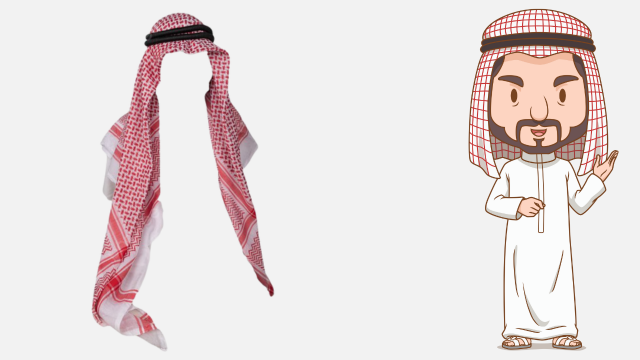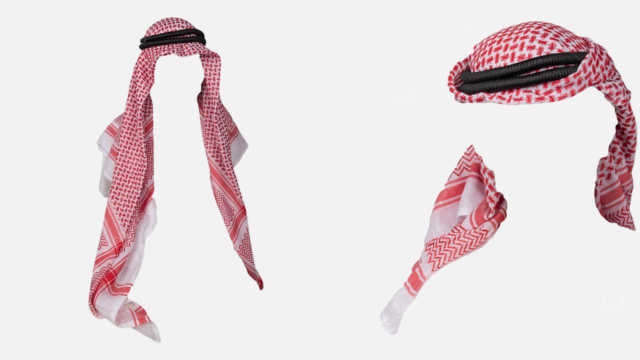Table of Contents
Introduction Ghutra Saudi Arabia
The ghutra is one of the most recognizable elements of Saudi Arabian attire, symbolizing tradition, identity, and culture. Worn primarily by men, this headdress carries a deep historical and cultural legacy while adapting to modern trends and fashion. This guide explores the origins, styles, cultural significance, and evolving role of the ghutra in Saudi society today.
Table of Contents
Toggle
What is the Ghutra? An Overview
The ghutra, also referred to as the shemagh or kufiya in some regions, is a square piece of cloth, traditionally worn folded into a triangle and placed over the head. It is often secured with an agal (a black cord) to hold it in place.
Primary Characteristics of the Ghutra:
- Colors: The most common styles are the all-white ghutra and the red-and-white-checkered ghutra (shemagh).
- Material: Ghutras are typically made from cotton, though some high-quality varieties include silk blends for added softness and durability.
- Occasions for Wearing: The ghutra can be worn daily or reserved for formal occasions, such as weddings, religious festivals, and national celebrations.
The Historical Significance of the Ghutra
The ghutra has roots in the Arabian Peninsula’s history, dating back centuries when it served both functional and cultural purposes.
Origins and Evolution:
- Practical Uses: Originally, the ghutra protected its wearer from the harsh desert environment, shielding against sun exposure, dust, and wind. This functional aspect made it indispensable for Bedouin life and travel.
- Symbol of Identity: The ghutra gradually became a symbol of national and tribal identity, with specific styles, colors, and patterns signifying a wearer’s regional or tribal affiliations.
Tradition and Heritage:
- Islamic and Cultural Ties: While the ghutra is not inherently religious, it aligns with Islamic customs emphasizing modesty. Men traditionally cover their heads as a sign of respect and honor.
- Cultural Pride: The ghutra plays a central role in Saudi national pride, representing the heritage of the Arabian Peninsula and the traditions passed down through generations.
Styles and Variations of the Ghutra in Saudi Arabia
The way a ghutra is worn can signify a range of meanings, from personal preference to adherence to tradition or even current trends in fashion.
Popular Styles:
- The White Ghutra: Often considered more formal and traditional, the plain white ghutra is favored during religious occasions and in professional settings. It symbolizes purity and is seen as a dignified choice for high-level events.
- The Red-and-White Shemagh: This version has gained popularity across Saudi Arabia and the Gulf region for its distinctive checked pattern. It is commonly worn for national celebrations, gatherings, and everyday life, reflecting cultural heritage.
- Unique Folding Techniques: Saudi men express their personal style and regional heritage through the way they fold and drape their ghutra. Common styles include:
- The Cobra Style: A modern, structured folding method where the ghutra is shaped to create a “cobra-like” form above the forehead.
- The Classic Drape: The ghutra hangs loosely over the shoulders, evoking a relaxed, traditional look.
- Formal and Structured Fold: This style is commonly used for official events and is neatly pressed and arranged, often with sharp lines.

The Role of the Agal
The agal, a black cord worn over the ghutra, plays both functional and symbolic roles. Traditionally used to secure the headdress, it also holds significance as a marker of cultural identity. Made from woven material, the agal adds an elegant touch and is commonly seen in formal settings.
Variations and Significance of the Agal:
- Black Agal: The standard, most common form of agal is black and made from camel hair or wool.
- Decorative Agals: In some instances, elaborate or decorative agals may be used, especially during national celebrations or for high-ranking individuals, adding a touch of personal style.
Modern Trends and Fashion Influence
The ghutra remains a powerful symbol of tradition, but it has also evolved to reflect modern trends and changing societal norms.
Fashion and the Ghutra:
- Designer Ghutras: Fashion designers have reimagined the ghutra, offering high-end versions with intricate patterns and unique fabrics. This has allowed it to become a statement of style, bridging traditional wear with modern fashion.
- Influence of Youth Culture: Young Saudi men often experiment with innovative ways to wear their ghutra, blending contemporary influences with respect for tradition. Social media and influencers have contributed to a resurgence of interest in showcasing different ghutra styles.
Cultural Adaptation and Preservation:
While the ghutra has adapted to contemporary influences, it remains firmly rooted in tradition. Wearing the ghutra is seen as a symbol of pride, connecting modern-day Saudis to their ancestors’ values, traditions, and heritage.
Significance During Special Occasions
The ghutra is central to numerous cultural and religious occasions, symbolizing respect, honor, and tradition.
Religious and Cultural Events:
- Eid Celebrations: During Eid al-Fitr and Eid al-Adha, men wear their finest ghutras to attend prayers, visit family, and participate in communal gatherings.
- Weddings and National Celebrations: For weddings and national holidays, the ghutra is worn with pride, often accompanied by traditional robes (bisht) for added elegance.
Government and Diplomatic Protocols:
- Dignitaries and Officials: Saudi officials, including diplomats and high-ranking leaders, often wear the ghutra and agal during meetings, reinforcing the symbol’s connection to tradition and national identity.
Cultural Adaptation and Preservation:
While the ghutra has adapted to contemporary influences, it remains firmly rooted in tradition. Wearing the ghutra is seen as a symbol of pride, connecting modern-day Saudis to their ancestors’ values, traditions, and heritage.
Significance During Special Occasions
The ghutra is central to numerous cultural and religious occasions, symbolizing respect, honor, and tradition.
Religious and Cultural Events:
- Eid Celebrations: During Eid al-Fitr and Eid al-Adha, men wear their finest ghutras to attend prayers, visit family, and participate in communal gatherings.
- Weddings and National Celebrations: For weddings and national holidays, the ghutra is worn with pride, often accompanied by traditional robes (bisht) for added elegance.
Government and Diplomatic Protocols:
- Dignitaries and Officials: Saudi officials, including diplomats and high-ranking leaders, often wear the ghutra and agal during meetings, reinforcing the symbol’s connection to tradition and national identity.
Practical Tips for Wearing and Maintaining the Ghutra
Wearing the ghutra properly requires attention to detail and respect for tradition. Here are some practical tips for maintaining and wearing it appropriately:
Folding and Wearing:
- Folding the Ghutra: Fold the square cloth diagonally to create a triangle, then drape it over your head, adjusting the length according to preference.
- Securing with the Agal: Place the agal over the ghutra to hold it in place. Ensure that it sits comfortably, with the desired level of tension.
Maintenance and Care:
- Ironing and Cleaning: The ghutra should be regularly washed and ironed to maintain a crisp, clean appearance.
- Storage: Fold and store in a way that prevents wrinkles and preserves the fabric’s quality.
The Ghutra and National Identity
The ghutra’s symbolism extends far beyond fashion—it embodies the spirit and values of Saudi Arabia. As an emblem of tradition, it carries historical weight while serving as a reminder of the country’s rich heritage.
Role in Nation Building:
- Unity and Tradition: The ghutra reflects unity, pride, and shared heritage, connecting generations and preserving cultural identity in a rapidly changing world.
- A Symbol of Modernization: As Saudi Arabia embraces change and modernization, the ghutra remains a timeless connection to the past while adapting to the future.
FAQs About the Ghutra in Saudi Arabia
Conclusion
The ghutra in Saudi Arabia represents far more than a piece of cloth—it symbolizes tradition, heritage, and evolving culture. From its roots as a functional necessity in the desert to its role as a modern fashion statement, the ghutra remains a powerful emblem of identity and pride. Whether worn for religious observance, cultural celebration, or daily life, it stands as a testament to Saudi Arabia’s enduring customs and evolving traditions.
